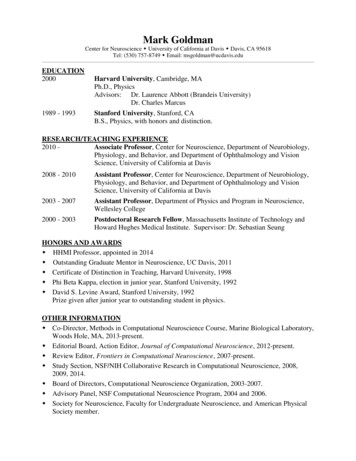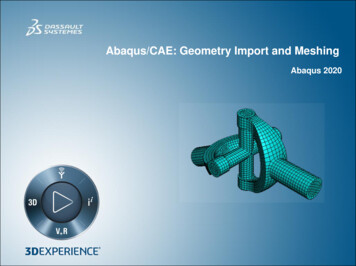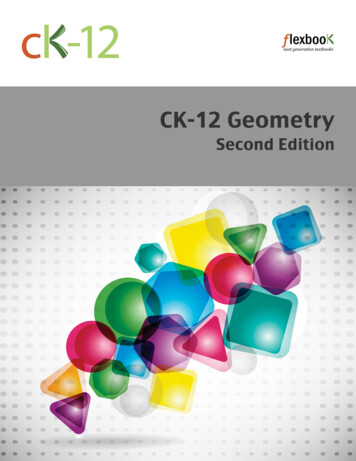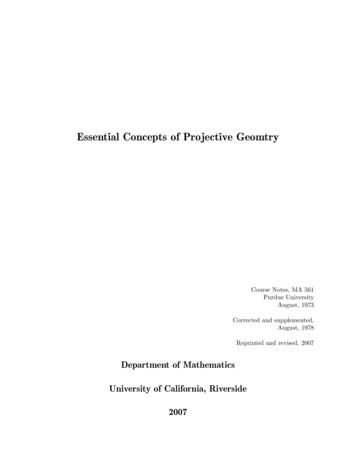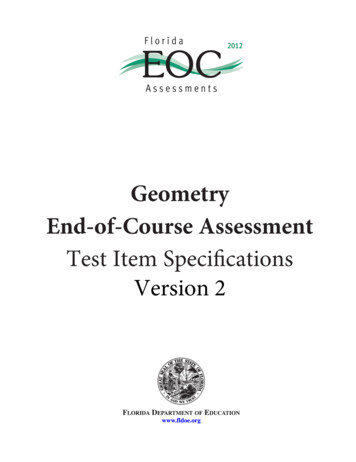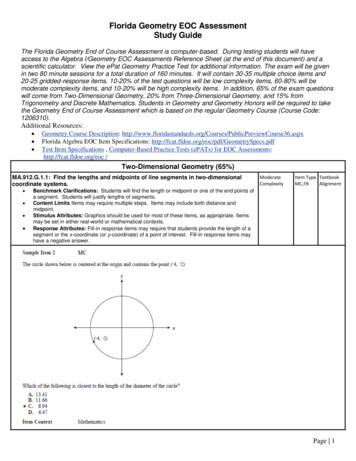
Transcription
COMPUTATIONAL GEOMETRYINTRODUCTIONPETR FELKELFEL CTU ku.php/courses/a4m39vg/startBased on [Berg] and [Kolingerova]Version from 8.10.2018
Computational Geometry1.2.3.4.5.6.7.8.9.10.What is Computational Geometry (CG)?Why to study CG and how?Typical application domainsTypical tasksComplexity of algorithmsProgramming techniques (paradigms) of CGRobustness IssuesCGAL – CG algorithm library introReferences and resourcesCourse summaryFelkel: Computational geometry(2)
1. What is Computational Geometry? CG Solves geometric problems that require clevergeometric algorithmsEx 1: Where is the nearest phone, metro, pub, ?Ex 2: How to get there?[Berg]Felkel: Computational geometry(3)
1.1 What is Computational Geometry? ( ) Ex 3: Map overlayCopyright: http://webhelp.esri.com/arcgisdesktopFelkel: Computational geometry(4)
1.2 What is Computational Geometry? ( ) Good solutions need both:– Understanding of thegeometric properties of the problem– Proper applications ofalgorithmic techniques (paradigms) and data structuresFelkel: Computational geometry(5)
1.3 What is Computational Geometry? ( ) Computational geometry systematic study of algorithms and data structures forgeometric objects (points, lines, line segments, n-gons, )with focus on exact algorithms that are asymptotically fast– “Born” in 1975 (Shamos), boom of papers in 90s(first papers sooner: 1850 Dirichlet, 1908 Voronoi, )– Many problems can be formulated geometrically(e.g., range queries in databases)Felkel: Computational geometry(6)
1.4 What is Computational Geometry? ( ) Problems:– Degenerate cases (points on line, with same x, ) Ignore them first, include later– Robustness - correct algorithm but not robust Limited numerical precision of real arithmetic Inconsistent eps tests (a b, b c, but a c) ?Nowadays:– focus on practical implementations, not just onasymptotically fastest algorithms– nearly correct result is better than nonsense or crashFelkel: Computational geometry(7)
2. Why to study computational geometry? Graphics- and Vision- Engineer should know it(„Data structures and algorithms in nth-Dimension“)- DSA, PRPSet of ready to use toolsYou will know new approaches to choose fromFelkel: Computational geometry(8)
2.1 How to teach computational geometry? Typical “mathematician” method:– definition-theorem-proof Our “practical” approach:– practical algorithms and their complexity– practical programing using a geometric library Is it OK for you?Felkel: Computational geometry(9)
3. Typical application domains Computer graphics––––– Collisions of objectsMouse localizationSelection of objects in regionVisibility in 3D (hidden surface removal)Computation of shadowsRobotics[Farag]– Motion planning (find path - environment with obstacles)– Task planning (motion planning order of subtasks)– Design of robots and working cells[Berg]Felkel: Computational geometry(10)
3.1 Typical application domains ( ) GIS– How to store huge dataand search them quickly– Interpolation of heights– Overlap of different data Extract information about regions or relations between data(pipes under the construction site, plants x average rainfall, ) Detect bridges on crossings of roads and rivers [Berg]CAD/CAM– Intersections and unions of objects– Visualization and tests without need to build a prototype– ManufacturabilityFelkel: Computational geometry(11)
3.2 Typical application domains ( ) Other domains– Molecular modeling– DB search– IC design[Berg][Berg][Berg]Felkel: Computational geometry(12)
4. Typical tasks in CG Geometric searching - fast location of :The nearest neighborPoints in given range(range query)Felkel: Computational geometry(13)
4.1 Typical tasks in CG Convex hull smallest enclosing convex polygon in E2 orn-gon in E3 containing all the pointsV – set of pointsConvex Hull CH(V )Felkel: Computational geometry(14)
4.2 Typical tasks in CG Voronoi diagrams– Space (plane) partitioning into regions whose points arenearest to the given primitive (most usually a point)Felkel: Computational geometry(15)
4.3 Typical tasks in CG Planar triangulations and space tetrahedronizationof given point set[Maur]Felkel: Computational geometry(16)
4.4 Typical tasks in CG Intersection of objects– Detection of common parts of objects– Usually linear (line segments, polygons, n-gons, )cbaFelkel: Computational geometry(17)
4.5 Typical tasks in CG Motion planning– Search for the shortest path between two points in theenvironment with obstacles[Berg]Felkel: Computational geometry(18)
5. Complexity of algorithms and data struc. We need a measure for comparison of algorithms– Independent on computer HW and prog. language– Dependent on the problem size n– Describing the behavior of the algorithm for different data Running time, preprocessing time, memory size– Asymptotical analysis – O(g(n)), W(g(n)), Q(g(n))– Measurement on real data Differentiate:– complexity of the algorithm (particular sort) and– complexity of the problem (sorting)– given by number of edges, vertices, faces, problem size– equal to the complexity of the best algorithmFelkel: Computational geometry(19)
5.1 Complexity of algorithms Worst case behavior– Running time for the “worst” data Expected behavior (average)– expectation of the running time for problems of particularsize and probability distribution of input data– Valid only if the probability distribution is the same asexpected during the analysis– Typically much smaller than the worst case behavior– Ex.: Quick sort O(n2) worst and O(n logn) expectedFelkel: Computational geometry(20)
6. Programming techniques (paradigms) of CG3 phases of a geometric algorithm development1. Ignore all degeneracies and design an algorithm2. Adjust the algorithm to be correct for degenerate cases––––Degenerate input existsIntegrate special cases in general caseIt is better than lot of case-switches (typical for beginners)e.g.:lexicographic order for points on vertical linesor Symbolic perturbation schemes3. Implement alg. 2 (use sw library)Felkel: Computational geometry(22)
6.1 Sorting A preprocessing stepSimplifies the following processing stepsSort according to:– coordinates x, y, , or lexicographically to [y,x],– angles around point O(n logn) time and O(n) spaceFelkel: Computational geometry(23)
6.2 Divide and Conquer (divide et impera) Split the problem until it is solvable, merge resultsDivideAndConquer(S)1. If known solution then return it2. else3.Split input S to k distinct subsets Si4.Foreach i call DivideAndConquer(Si)5.Merge the results and return the solution Prerequisite– The input data set must be separable– Solutions of subsets are independent– The result can be obtained by merging of sub-resultsFelkel: Computational geometry(24)
6.3 Sweep algorithm Split the space by a hyperplane (2D: sweep line)– “Left” subspace – solution known– “Right” subspace – solution unknown Stop in event points and update the statusData structures:– Event points – points, where to stop the sweep lineand update the status, sorted– Status – state of the algorithm in the current position ofthe sweep line Prerequisite:– Left subspace does not influence the right subspaceFelkel: Computational geometry(25)
6.3b Sweep-line algorithmcEvent types for segments:- start- end- intersectionbaEvent points – ordered in event queueStatus: {a}, {a,b}, {c,a,b}, {c,b,a}, Felkel: Computational geometry(26)
6.4 Prune and search Eliminate parts of the state space, where thesolution clearly does not exist – Binary search prune– Search trees– Back-tracking (stop if solution worse than currentoptimum)152346789Felkel: Computational geometry(27)
6.5 Locus approach Subdivide the search space into regions ofconstant answerUse point location to determine the region– Nearest neighbor search exampleRegion of theconstant answer:All points in thisregion are nearestto the yellow pointFelkel: Computational geometry(28)
6.6 Dualisation Use geometry transform to change the probleminto another that can be solved more easilyPoints hyper planes– Preservation of incidence (A œ p fl p*œ A*) Ex. 2D: determine if 3 points lie on a common lineA*CpBp* AB*Felkel: Computational geometry(29)C*
6.7 Combinatorial analysis The branch of mathematics which studies thenumber of different ways of arranging things Ex. How many subdivisions of a point set can bedone by one line?Felkel: Computational geometry(30)
6.8 New trends in Computational geometry From 2D to 3D and more from mid 80s, from linearto curved objectsFocus on line segments, triangles in E3 and hyperplanes in EdStrong influence of combinatorial geometryRandomized algorithmsSpace effective algorithms (in place, in situ, datastream algs.)Robust algorithms and handling of singularitiesPractical implementation in libraries (CGAL, )Approximate algorithmsFelkel: Computational geometry(31)
7. Robustness issues Geometry in theory is exactGeometry with floating-point arithmetic is not exact– Limited numerical precision of real arithmetic– Numbers are rounded to nearest possible representation– Inconsistent epsilon tests (a b, b c, but a c) Naïve use of floating point arithmetic causesgeometric algorithm to– Produce slightly or completely wrong output– Crash after invariant violation– Infinite loopFelkel: Computational geometry(32)[siggraph2008-CGAL-course]
Geometry in theory is exact ccw(s,q,r) & ccw(p,s,r) & ccw(p,q,s) ccw(p,q,r)psrq Correctness proofs of algorithms rely on suchtheoremsFelkel: Computational geometry(33)[siggraph2008-CGAL-course]
Geometry with float. arithmetic is not exact ccw(s,q,r) & !ccw(p,s,r) & ccw(p,q,s) ccw(p,q,r)pwrong result of the orientation predicatesrq Correctness proofs of algorithms rely on suchtheorems such algorithms failFelkel: Computational geometry(34)[siggraph2008-CGAL-course]
Floating-point arithmetic is not exacta) Limited numerical precision of real numbers Numbers represented as normalized23 bits stored m2e4 Bytes52 bits stored8 Bytes[http://cs.wikipedia.org/wiki/Soubor:Single double extended2.gif] The mantissa m is a 24-bit (53-bit) value whosemost significant bit (MSB) is always 1 and is,therefore, not stored.Stored numbers are rounded to 24/53 bits mantissa– lower bits are lostFelkel: Computational geometry(35)
Floating-point special values 00000000000000000 Infinity 00000001Felkel: Computational geometry(36)
Floating-point arithmetic is not exactb) Smaller numbers are shifted right during additionsand subtractions to align the digits of the same orderExample for float:Invisible leading bit – not stored 12 – p for p 0.5 23 1Normalized mantisa 23 bit– 1210 11002 0100000101000000000000000000000022-1 1– p 0.510 00111111000000000000000000000000 21– p 0.500000810 00111111000000000000000000001101 2– Mantissa of p is shifted 4 bits right to align with 12(to have the same exponent 23)p 0.500000810 01000001000010000000000000000000 21101– four least significant bits (LSB) are lost– The result is 11.5 instead of 11.4999992Felkel: Computational geometry(37)
Floating-point arithmetic is not exactb) Smaller numbers are shifted right during additionsand subtractions to align the digits of the same orderExample for float: 12 – p for p 0.5 (such as 0.5 2 (-23) )– Mantissa of p is shifted 4 bits right to align with 12– four least significant bits (LSB) are lost 24 – p for p 0.5– Mantissa of p is shifted 5 bits right to align with 24 - 5 LSB are lostTry it on tml ml]Felkel: Computational geometry(38)
Orientation predicate - definitionrqThree points– lie on common line– form a left turn– form a right turn 0 1 (positive) –1 (negative)Felkel: Computational geometry(39)p
Experiment with orientation predicate orientation(p,q,r) sign((px-rx)(qy-ry)-(py-ry)(qx-rx))r [24, 24]Ideal return values left turndy,q [12, 12]doublep [0.5 dx , 0.5 dy], dx , dy k.2-53– right turnp[0.5, 0.5]dx,Felkel: Computational geometry(40)Value of the LSB
Real results of orientation predicate orientation(p,q,r) sign((px-rx)(qy-ry)-(py-ry)(qx-rx))Return values during the experiment for exponent -52 left turndy,Where is the yellow line?Robust predicate returnsslightly non-zero valuesorientation , ,– right turn 0Never lie on common linepFelkel: Computational geometry(41)
Real results of orientation predicate orientation(p,q,r) sign((px-rx)(qy-ry)-(py-ry)(qx-rx))Return values during the experiment for exponent -52Pivot rPivot p24Felkel: Computational geometry(42)0.5
Floating point orientation predicate double exp -53Pivot p[Kettner] with correct coolorsFelkel: Computational geometry(43)
Errors from shift 0.5 right in subtraction 4 bits shift 24 values rounded to the same value0 85 bits shift 25 values rounded to the same value0 16 24 32 40 48 56 64 72 80163248648096Combined intervals of size 8, 16, 24, 0816 24 32 40 48 56 64 72 80 88Felkel: Computational geometry(44)
Orientation predicate – pivot selection4 bits lost5 bits lost4 bits lost4 bits lost5 bits lost4 bits lost5 bits lost5 bits lostFelkel: Computational geometry(45)
Little improvement - selection of the pivot(b) double exp -53 Pivot – subtracted from the rows in the matrixPivot p0.5Pivot q12Pivot r24 Pivot q (point with middle x or y coord.) is the bestBut it is typically not used – pivot search is toocomplicated in comparison to the predicateitself[Kettner]Felkel: Computational geometry(46)
Epsilon tweaking – is the wrong approach Use tolerance ε 0.00005 to 0.0001 for floatPoints are declared collinear if float orient returnsa value ε0.5 2 (-23) , the smallest repr. value 0.500 000 06IdeaIdea: boundary for ε RealityRealityBoundary for ε 0.00005Boundary for ε 0.0001Boundary is fractured as before, but brighterFelkel: Computational geometry(47)[Kettner]
Consequences in convex hull algorithm[Kettner04]p5 erroneously insertedInserting p6 a) p6 sees p4p5 first forms p4 p6 p5Felkel: Computational geometry(48)b) p6 sees p1p2 first forms p1 p6 p2
Exact Geometric Computing [Yap]Make sure that the control flow in theimplementation corresponds to the control flowwith exact real arithmeticFelkel: Computational geometry(49)[siggraph2008-CGAL-course]
Solution1.2.3.Use predicates, that always return the correctresult - Schewchuck, YAP, LEDA or CGALChange the algorithm to cope with floating pointpredicates but still return something meaningful(hard to define)Perturb the input so that the floating pointimplementation gives the correct result on itFelkel: Computational geometry(50)
8. CGALComputational GeometryAlgorithms LibrarySlides from [siggraph2008-CGAL-course]Felkel: Computational geometry(51)
CGAL Large library of geometric algorithms– Robust code, huge amount of algorithms– Users can concentrate on their own domain Open source project– Institutional members(Inria, MPI, Tel-Aviv U, Utrecht U, Groningen U, ETHZ,Geometry Factory, FU Berlin, Forth, U Athens)– 500,000 lines of C code– 10,000 downloads/year ( Linux distributions)– 20 active developers– 12 months release cycleFelkel: Computational geometry(52)
CGAL algorithms and data structuresFelkel: Computational geometry(53)[siggraph2008-CGAL-course]
Exact geometric computingPredicatesorientationConstructionsin circleintersectionFelkel: Computational geometry(54)circumcenter[siggraph2008-CGAL-course]
CGAL Geometric Kernel (see [Hert] for details) Encapsulates– the representation of geometric objects– and the geometric operations and predicates on these objects CGAL provides kernels for––––Points, Predicates, and ExactnessNumber TypesCartesian RepresentationHomogeneous RepresentationFelkel: Computational geometry(55)
Points, predicates, and ExactnessFelkel: Computational geometry(56)[CGAL at SCG ‘99]
Number TypesPrecissionxslow-downFelkel: Computational geometry(57)[CGAL at SCG ‘99]
Cartesian with double Felkel: Computational geometry(58)[CGAL at SCG ‘99]
Cartesian with double Felkel: Computational geometry(59)[CGAL at SCG ‘99]
Cartesian with Filtered exact and leda realNumber type A single-line declarationchanges theprecision of all computationsFelkel: Computational geometry(60)[CGAL at SCG ‘99]
Exact orientation test – homogeneous rep.Felkel: Computational geometry(61)[CGAL at SCG ‘99]
9 References – for the lectures Mark de Berg, Otfried Cheong, Marc van Kreveld, Mark Overmars:Computational Geometry: Algorithms and Applications, Springer-Verlag,3rd rev. ed. 2008. 386 pages, 370 fig. ISBN: t] Mount, D.: Computational Geometry Lecture Notes for Spring /Lects/comp-geomlects.pdfFranko P. Preperata, Michael Ian Shamos: Computational Geometry. AnIntroduction. Berlin, Springer-Verlag,1985Joseph O Rourke: .: Computational Geometry in C, Cambridge UniversityPress, 1993, ISBN 0-521- 44592-2http://maven.smith.edu/ orourke/books/compgeom.htmlIvana Kolingerová: Aplikovaná výpočetní geometrie, Přednášky, MFF UK2008Kettner et al. Classroom Examples of Robustness Problems in GeometricComputations, CGTA 2006,http://www.mpi-inf.mpg.de/ kettner/pub/nonrobust cgta 06.pdfFelkel: Computational geometry(62)
9.1 References – CGALCGAL www.cgal.org Kettner, L.: Tutorial I: Programming with CGAL Alliez, Fabri, Fogel: Computational Geometry Algorithms Library,SIGGRAPH 2008Susan Hert, Michael Hoffmann, Lutz Kettner, Sylvain Pion, and MichaelSeel. An adaptable and extensible geometry kernel. ComputationalGeometry: Theory and Applications, 38:16-36, 2007.[doi:10.1016/j.comgeo.2006.11.004]Felkel: Computational geometry(63)
9.2 Useful geometric tools OpenSCAD - The Programmers Solid 3D CAD Modeler,http://www.openscad.org/ J.R. Shewchuk - Adaptive Precision Floating-Point Arithmetic and FastRobust Predicates, Effective implementation of Orientation and InCirclepredicates http://www.cs.cmu.edu/ quake/robust.htmlOpenMESH - A generic and efficient polygon mesh data structure,https://www.openmesh.org/ VCG Library - The Visualization and Computer Graphics Library,http://vcg.isti.cnr.it/vcglib/ MeshLab - A processing system for 3D triangular meshes https://sourceforge.net/projects/meshlab/?source navbarFelkel: Computational geometry(64)
9.3 Collections of geometry resources N. Amenta, Directory of Computational Geometry D. Eppstein, Geometry in Action,http://www.ics.uci.edu/ eppstein/geom.html.Jeff Erickson, Computational Geometry Pages,http://compgeom.cs.uiuc.edu/ jeffe/compgeom/Felkel: Computational geometry(65)
10. Computational geom. course summary Gives an overview of geometric algorithmsExplains their complexity and limitationsDifferent algorithms for different dataWe focus on– discrete algorithms and precise numbers and predicates– principles more than on precise mathematical proofs– practical experiences with geometric swFelkel: Computational geometry(66)
Felkel: Computational geometry (6) 1.3 What is Computational Geometry? ( ) Computational geometry systematic study of algorithms and data structures for geometric objects (points, lines, line segments, n-gons, )

